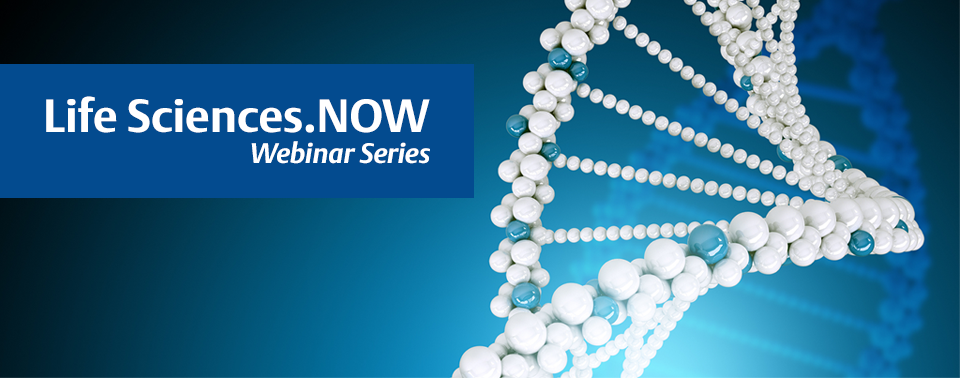
This Life Sciences.Now webinar series will provide direction and updates on key manufacturing operation initiatives to improve operational certainty, deliver cost effective quality and regulatory compliance and accelerate the product development pipeline.
The series format will provide: -
Why Attend: -
Different panel members will join specific topics and available during the Q&A at the end of each Webinar. Each of the presentation’s will be approximately 30 minutes followed by Q&A.
We encourage you to attend all 8 Webinars in the series but please feel free to pick and choose the topics of most interest, as a single registration will get you access to all Webinars.
Apply the BioPhorum Digital Plant Maturity Model to Transform your Operations

Speakers: Alan Johnson and Zigor Lizuain
Beginning your digital transformation journey can be challenging. This Webinar will discuss Emerson’s structured Digital Transformation approach, incorporating the BioPhorum Digital Plant Maturity Model, define your business challenges and benefits, assess your current state and identify key opportunities to move your operations to the next level. Determine how to get started, how to plan the strategy and where to focus.
Learn how you can:
Delivering Value of Manufacturing Execution Systems and Phased Deployment

Speakers: Johan Zebib and Vivek Kasture
This Webinar will explore how ‘Right first time’ manufacturing has always been important in the Life Sciences Industry. This can be particularly challenging when manual operations and paper documents are used across operations. Different types of MES solutions can be deployed to address specific challenges. Some of these solutions can be categorized as follows: -
Learn how you can:
Optimize Life Sciences Facility Throughput

Speakers: David Zhang and Ron Rossbach
This webinar will discuss how Life Sciences companies strive to optimize utilization in their manufacturing operations and delivering maximum facility performance as part the overall supply chain is an important operations initiative. As production volumes grow, it is critical to identify potential bottle-necks, determine how to address them, and avoid supply chain problems while ensuring patient safety. Additionally, when supply chain develops the overall production plan, continuously managing this plan in the face of changing priorities and problems on the production floor can be a real challenge.
Learn how you can:
Implement Easy, Flexible Manufacturing Leveraging Common Modules and new Plug and Play Technologies

Speakers: Kelsey Hill and Klaus Erni
This Webinar will examine how as organizations respond quickly to changing market demands, a flexible manufacturing floor has become a critical initiative. Manufacturing “ballrooms”, where it’s easy to change the manufacturing process line to create a new product, has been a goal for many years. The lack of standardized data and service interactions as well as the difficulties integrating the automation components across various types of process equipment have made this too complex to easily achieve. New integration technologies such as OPC UA and industry application approaches like the NAMUR 148 Module Type Package (MTP) are simplifying this approach to make it easy to connect equipment to “balance of plant” automation management systems.
Learn how you can:
Improve Life Sciences Equipment Uptime

Speakers: Dennis Belanger and Nick Lubenetski
This Webinar will explore how as Life Sciences companies move to continuous manufacturing with fully utilized facilities, avoiding unplanned equipment problems and associated downtime has become an important reliability initiative. Asset Lifecycle Programs that identify and prioritize critical equipment, change from routine preventive maintenance practices to predicting failures, and manage equipment performance in real-time have become the new norm.
Learn how you can:
Get to Market Faster and Reduce Risk with the Emerson Digital Twin

Speakers: Ronnie Bains and Zachary Sample
This Webinar will explore why historically, process simulation has not been widely applied in the Life Sciences industry. However, the Emerson Digital Twin provides game changing technology, which can be applied to a wide range of activities throughout the lifecycle of a Life Sciences facility.
Learn how you can:
Accelerate the Technology Transfer Process for your Product Development Pipeline

Speakers: Michalle Adkins and Ron Rossbach
This Webinar will discuss, as recent events demonstrate, reducing time to market for a new therapy is a key opportunity for Life Sciences companies. New developments in Process Knowledge Management, information exchange standards and overall Life Sciences data management and data exchanges are making this historic “wish list item” for process automation a reality. As common execution system building blocks align with high level process design and development tools, the ability to automate data collection and deploy execution system recipes across the enterprise is expanding.
Learn how you can:
Ensure Product Quality in Real-Time through Process Analytical Technologies

Speakers: John Caldwell and Mark Brewer
This Webinar will discuss the use of Process Analytical Technologies (PAT). Although PAT have been applied for many years the current solution is managed across several systems, making it rigid and difficult to maintain. Moving lab quality measurements to in-line, real-time, “closed loop” control is a growing requirement as the industry transforms to continuous manufacturing.
Learn how you can: